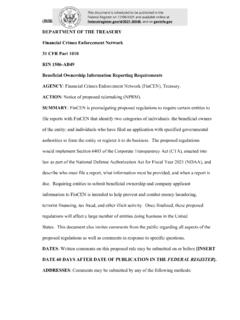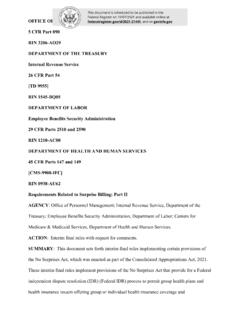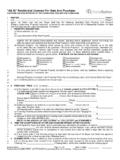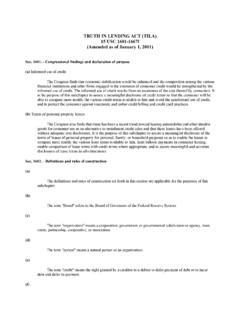Transcription of 12 CFR Part 213 Docket No. R-1756 RIN 7100-AG19 BUREAU …
1 FEDERAL RESERVE SYSTEM 12 CFR Part 213 Docket No. R-1756 RIN 7100-AG19 BUREAU OF CONSUMER FINANCIAL PROTECTION12 CFR Part 1013 Consumer Leasing (Regulation M)AGENCY: Board of Governors of the Federal Reserve System (Board) and BUREAU of Consumer Financial Protection ( BUREAU ).ACTION: Final rules, official interpretations and : The Board and the BUREAU are finalizing amendments to the official interpretations and commentary for the agencies regulations that implement the Consumer Leasing Act (CLA). The Dodd-Frank Wall Street Reform and Consumer Protection Act (Dodd-Frank Act) amended the CLA by requiring that the dollar threshold for exempt consumer leases be adjusted annually by the annual percentage increase in the Consumer Price Index for Urban Wage Earners and Clerical Workers (CPI-W).
2 Under regulations adopted by the Board and the BUREAU , if there is no annual percentage increase in the CPI-W, the Board and the BUREAU will not adjust this exemption threshold from the prior year. However, in years following a year in which the exemption threshold was not adjusted, the threshold is calculated by applying the annual percentage change in the CPI-W to the dollar amount that would have resulted, after rounding, if the decreases and any subsequent increases in the CPI-W had been taken into account. Based on the annual percentage increase in the CPI-W as of June 1, 2021, the exemption threshold will increase from $58,300 to $61,000 effective January 1, 2022. Because the Dodd-Frank Act also requires similar adjustments in the truth in lending Act s threshold for exempt consumer credit transactions, the Board and the BUREAU are making similar amendments This document is scheduled to be published in theFederal Register on 11/30/2021 and available online , and each of their respective regulations implementing the truth in lending Act elsewhere in the Rules section of this issue of the Federal Register.
3 DATES: This final rule is effective January 1, FURTHER INFORMATION CONTACT: Board: Vivian W. Wong, Senior Counsel, Division of Consumer and Community Affairs, Board of Governors of the Federal Reserve System, at (202) : Lanique Eubanks, Senior Counsel, Office of Regulations, BUREAU of Consumer Financial Protection, at (202) 435-7700. If you require this document in an alternative electronic format, please contact SUPPLEMENTARY INFORMATION:I. BackgroundThe Dodd-Frank Act increased the threshold in the CLA for exempt consumer leases, and the threshold in the truth in lending Act (TILA) for exempt consumer credit transactions,1 from $25,000 to $50,000, effective July 21, In addition, the Dodd-Frank Act requires that, on and after December 31, 2011, these thresholds be adjusted annually for inflation by the annual percentage increase in the CPI-W, as published by the BUREAU of Labor Statistics.
4 In April 2011, the Board issued a final rule amending Regulation M (which implements the CLA) consistent with these provisions of the Dodd-Frank Act, along with a similar final rule amending Regulation Z (which implements TILA) (collectively, the Board Final Threshold Rules).3 Title X of the Dodd-Frank Act transferred rulemaking authority for a number of consumer financial protection laws from the Board to the BUREAU , effective July 21, 2011. In connection with this transfer of rulemaking authority, the BUREAU issued its own Regulation M 1 Although consumer credit transactions above the threshold are generally exempt, loans secured by real property or by personal property used or expected to be used as the principal dwelling of a consumer and private education loans are covered by TILA regardless of the loan amount.
5 See 12 CFR (b)(1)(i) (Board) and 12 CFR (b)(1)(i) ( BUREAU ).2 Pub. L. 111-203, section 1100E, 124 Stat. 1376, 2111 (2010). 3 76 FR 18349 (Apr. 4, 2011); 76 FR 18354 (Apr. 4, 2011).implementing the CLA, 12 CFR part 1013, substantially duplicating the Board s Regulation Although the BUREAU has the authority to issue rules to implement the CLA for most entities, the Board retains authority to issue rules under the CLA for certain motor vehicle dealers covered by section 1029(a) of the Dodd-Frank Act, and the Board s Regulation M continues to apply to those The Board s and the BUREAU s regulations,6 and their accompanying commentaries, provide that the exemption threshold will be adjusted annually effective January 1 of each year based on any annual percentage increase in the CPI-W that was in effect on the preceding June 1.
6 They further provide that any increase in the threshold amount will be rounded to the nearest $100 increment. For example, if the annual percentage increase in the CPI-W would result in a $950 increase in the threshold amount, the threshold amount will be increased by $1,000. However, if the annual percentage increase in the CPI-W would result in a $949 increase in the threshold amount, the threshold amount will be increased by $ Since 2011, the Board and the BUREAU have adjusted the Regulation M exemption threshold annually, in accordance with these rules. On November 30, 2016, the Board and the BUREAU published a final rule in the Federal Register to memorialize the calculation method used by the agencies each year to adjust the exemption threshold to ensure that, as contemplated by section 1100E(b) of the Dodd-Frank Act, the values for the exemption threshold keep pace with the CPI-W (Regulation M Adjustment 4 See 76 FR 78500 (Dec.))
7 19, 2011); 81 FR 25323 (Apr. 28, 2016).5 Section 1029(a) of the Dodd-Frank Act states: Except as permitted in subsection (b), the BUREAU may not exercise any rulemaking, supervisory, enforcement, or any other authority .. over a motor vehicle dealer that is predominantly engaged in the sale and servicing of motor vehicles, the leasing and servicing of motor vehicles, or both. 12 5519(a). Section 1029(b) of the Dodd-Frank Act provides that [s]ubsection (a) shall not apply to any person, to the extent that such person (1) provides consumers with any services related to residential or commercial mortgages or self-financing transactions involving real property; (2) operates a line of business (A) that involves the extension of retail credit or retail leases involving motor vehicles; and (B) in which (i) the extension of retail credit or retail leases are provided directly to consumers; and (ii) the contract governing such extension of retail credit or retail leases is not routinely assigned to an unaffiliated third party finance or leasing source.
8 Or (3) offers or provides a consumer financial product or service not involving or related to the sale, financing, leasing, rental, repair, refurbishment, maintenance, or other servicing of motor vehicles, motor vehicle parts, or any related or ancillary product or service. 12 5519(b).6 12 CFR (e)(1) (Board) and 12 CFR (e)(1) ( BUREAU ).7 See comments 2(e)-9 in Supplements I of 12 CFR parts 213 and Rule).8 The Regulation M Adjustment Calculation Rule memorialized the policy that, if there is no annual percentage increase in the CPI-W, the Board and the BUREAU will not adjust the exemption threshold from the prior year. The Regulation M Adjustment Calculation Rule also provided that, in years following a year in which the exemption threshold was not adjusted because there was a decrease in the CPI-W from the previous year, the threshold is calculated by applying the annual percentage change in the CPI-W to the dollar amount that would have resulted, after rounding, if the decreases and any subsequent increases in the CPI-W had been taken into account.
9 If the resulting amount calculated, after rounding, is greater than the current threshold, then the threshold effective January 1 the following year will increase accordingly; if the resulting amount calculated, after rounding, is equal to or less than the current threshold, then the threshold effective January 1 the following year will not change, but future increases will be calculated based on the amount that would have resulted, after rounding. II. 2022 Adjustment and Commentary RevisionEffective January 1, 2022, the exemption threshold amount is increased from $58,300 to $61,000. This amount is based on the CPI-W in effect on June 1, 2021, which was reported on May 12, 2021 (based on April 2021 data).9 The CPI-W is a subset of the CPI-U index (based on all urban consumers) and represents approximately 29 percent of the population.
10 The CPI-W reported on May 12, 2021 reflects a percent increase in the CPI-W from April 2020 to April 2021. Accordingly, the percent increase in the CPI-W from April 2020 to April 2021 results in an exemption threshold amount of $61,000, after rounding. The Board and the BUREAU are revising the commentaries to their respective regulations to add new comment 2(e) to 8 See 81 FR 86256 (Nov. 30, 2016).9 The BUREAU of Labor Statistics calculates consumer-based indices for each month, but does not report those indices until the middle of the following month. As such, the most recently reported indices as of June 1, 2021 were reported on May 12, 2021, and reflect economic conditions in April that, from January 1, 2022 through December 31, 2022, the threshold amount is $61,000.
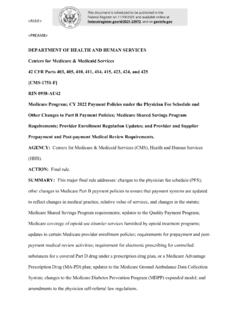
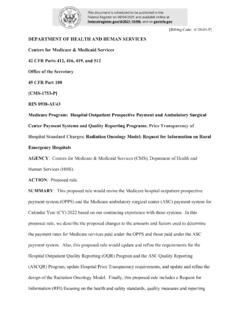
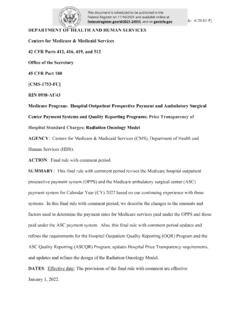
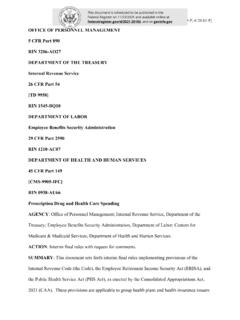
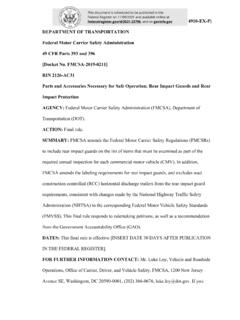
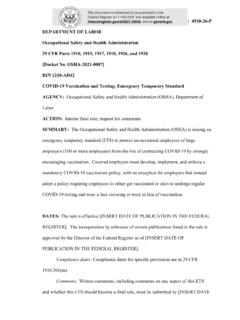
![DEPARTMENT OF COMMERCE [Docket No. 211213-0259] …](/cache/preview/2/2/6/7/7/8/1/2/thumb-22677812e7ac1183a3a0b47ebea8a362.jpg)
